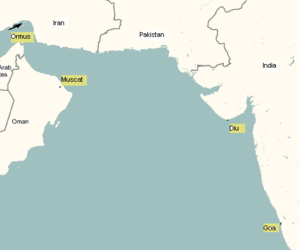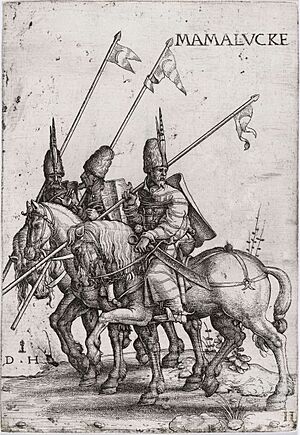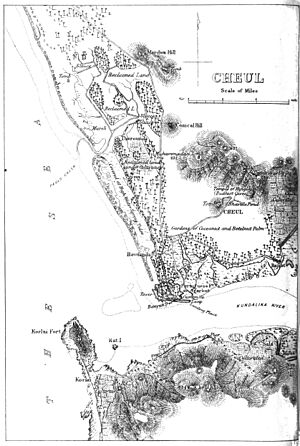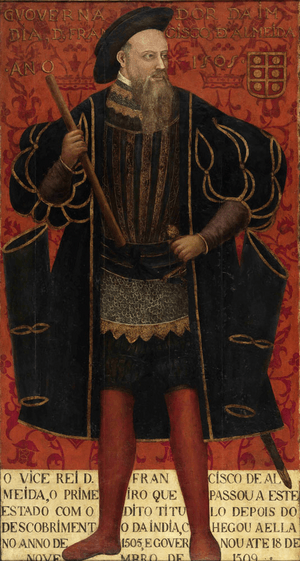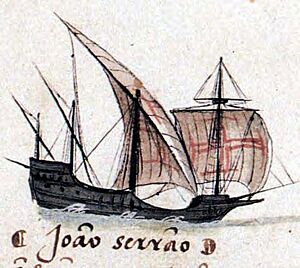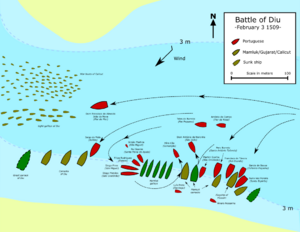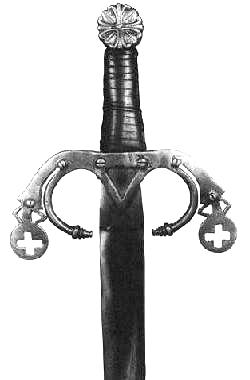Battle of Diu facts for kids
Quick facts for kids Battle of Diu |
|||||||
|---|---|---|---|---|---|---|---|
| Part of the Mamluk–Portuguese conflicts , Gujarati–Portuguese conflicts and Ottoman-Portuguese confrontations | |||||||
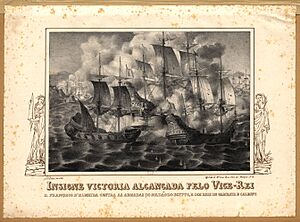 Notable victory achieved by the Viceroy D. Francisco de Almeida against the navies of the Sultan of Egypt and the Kings of Cambay and Calicut. Lithograph by Maurício José do Carmo Sendim, 1840 |
|||||||
|
|||||||
| Belligerents | |||||||
|
|||||||
| Commanders and leaders | |||||||
| Strength | |||||||
| Casualties and losses | |||||||
332 total
|
|
||||||
The Battle of Diu was a major naval battle fought on February 3, 1509. It took place in the Arabian Sea, near the port of Diu in India. This important battle was fought between the powerful Portuguese Empire and a combined fleet. This combined fleet included forces from the Gujarat Sultanate, the Mamluk Sultanate of Egypt, and the Kingdom of Calicut.
The Portuguese won a critical victory. This defeat weakened the Muslim alliance. It helped Portugal control the Indian Ocean trade routes. They could now send spices and goods around the Cape of Good Hope. This avoided the older routes controlled by Arab and Venetian traders through the Red Sea. After this battle, Portugal quickly took over key ports like Goa and Malacca. This victory greatly boosted the Portuguese Empire's power. It made them the main naval force in the East for over a century.
The Battle of Diu is seen as one of the most important naval battles in history. It marked the start of European control over Asian seas. This control lasted until the Second World War.
Contents
Why the Battle Happened
Just two years after Vasco da Gama reached India by sea, the Portuguese faced problems. Muslim merchants on India's western coast opposed their trade. These merchants encouraged attacks on Portuguese trading posts and ships. They also caused the massacre of the Portuguese in Calicut in 1500.
The Portuguese then made an alliance with the Raja of Cochin. Cochin was an enemy of Calicut. The Portuguese set up their main base there. In response, the Zamorin of Calicut attacked Cochin. But the Portuguese managed to damage Calicut's lands and trade. Calicut was then the main exporter of spices to Europe. In 1504, the Portuguese destroyed the Zamorin's spice fleet heading for Egypt.
King Manuel I of Portugal heard about these events. He chose Dom Francisco de Almeida to be the first viceroy of India. His orders were to protect Portuguese trading posts and stop hostile Muslim ships. Dom Francisco left Lisbon in 1505 with 20 ships. His son, Dom Lourenço, joined him as the captain-major of the sea of India.
Portuguese actions were greatly disrupting Muslim trade in the Indian Ocean. This also affected the Venetians. The Portuguese could sell spices cheaper in Europe. Unable to stop the Portuguese, Muslim traders and the Zamorin of Calicut asked Egypt for help.
Egypt's Role in the Conflict
In the early 1500s, the Mamluk Sultanate of Egypt was a key middleman. They connected spice-producing India with Venetian buyers in the Mediterranean. Venice then sold these spices across Europe for a large profit. Egypt itself was mostly a farming society with little sea experience.
Venice broke ties with Portugal. They looked for ways to stop Portugal's influence in the Indian Ocean. Venice even sent an ambassador to the Mamluk court. They suggested quick actions against the Portuguese.
Mamluk soldiers were not skilled in naval warfare. So, the Mamluk Sultan, Al-Ashraf Qansuh al-Ghawri, asked Venice for help. Venice provided Mediterranean-style ships and war galleys. Greek sailors manned these ships. Venetian shipbuilders helped take them apart in Alexandria and rebuild them at Suez. These galleys could carry cannons at the front and back. But they could not have guns along the sides because of the rowers. Local ships, called dhows, could only carry very light guns.
A Kurdish Mamluk, Amir Hussain Al-Kurdi, led the Mamluk expedition. The fleet included Egyptian Mamluks, Turkish, Nubian, and Ethiopian fighters. It also had Venetian gunners. This meant most of the coalition's artillery were archers. The Portuguese could easily outshoot them.
The fleet left Suez in November 1505 with 1100 men. They were ordered to fortify Jeddah and stop rebellions. They spent the monsoon season on Kamaran island. Then they landed at Aden, getting involved in local politics. Finally, they crossed the Indian Ocean. They reached Diu in September 1507. This journey could have taken only a month.
Diu and Malik Ayyaz
When the Portuguese arrived in India, the Gujarati people were major traders. They handled long-distance trade in the Indian Ocean. They were key in connecting Egypt and Malacca, trading cloths and spices. In the 15th century, the Sultan of Gujarat made Malik Ayyaz the governor of Diu. Malik Ayyaz was a clever and practical ruler. He made Diu the main port of Gujarat. It became a major trading hub between India and the Persian Gulf.
Malik Ayyaz avoided conflict with the Portuguese. He tried to keep peace and even align with them. This changed when Hussain's fleet unexpectedly arrived in Diu. Malik Ayyaz welcomed Hussain. But other Indian rulers did not want to fight the Portuguese, unlike what the Muslim envoys had promised. Ayyaz knew the Portuguese were a strong naval force. He did not want to make them angry. However, he could not refuse Hussain. He feared the powerful Sultan of Gujarat and Hussain's own forces. Caught in a difficult situation, Ayyaz decided to only cautiously support Hussain.
The Battle of Chaul
In March 1508, Hussain's and Ayyaz's fleets sailed south. They fought Portuguese ships in a three-day battle in the harbor of Chaul. The Portuguese commander was Lourenço de Almeida, the viceroy's son. He was there to oversee merchant ships and escort them back to Cochin.
The Portuguese were surprised by the attack. Hussain's European-like ships were first thought to be friendly. The battle ended in a costly victory for the Muslims. They suffered too many losses to continue to the Portuguese base in Cochin. The Portuguese flagship was sunk, but the rest of their fleet escaped. Hussain himself barely survived. This was because Malik Ayyaz was not fully committed to the battle. Hussain had to return to Diu with Malik Ayyaz. They prepared for a Portuguese counter-attack. Hussain reported this battle as a great victory to Cairo. However, a Persian account of Gujarat called it a minor skirmish.
Sadly, Lourenço, the viceroy's son, was among the dead. His body was never found. Malik Ayyaz tried his best to recover it for the Portuguese viceroy.
Portuguese Preparations
When Dom Francisco de Almeida heard about his son's death in Cochin, he was heartbroken. He stayed in his room for three days, refusing to see anyone. A Mamluk fleet in India was a serious threat to the Portuguese. But the viceroy now wanted revenge for his son's death. He reportedly said, "he who ate the chick must also eat the rooster or pay for it."
The monsoon season was coming, bringing storms that stopped all sailing until September. Only then could the viceroy gather all available Portuguese ships. He had them repaired and assembled his forces in Cochin.
Before they could leave, Afonso de Albuquerque arrived in Cannanore on December 6, 1508. He had orders from the King of Portugal to replace Almeida as governor. Dom Francisco had a personal dislike for Albuquerque. Albuquerque's job was to stop Muslim ships from using the Red Sea. But Almeida's desire for revenge for his son's death became so strong. He refused to let his replacement take office. By doing this, the viceroy was rebelling against the king. He would rule Portuguese India for another year.
On December 9, the Portuguese fleet left for Diu.
The Fleet Moves Out
From Cochin, the Portuguese fleet first went to Calicut. They hoped to stop the Zamorin's fleet, but it had already left for Diu. The fleet then stopped at Baticala (Bhatkal). There, they settled a dispute between the king and a local Hindu privateer allied with Portugal, Timoja. In Honavar, the Portuguese met Timoja. He told the viceroy about enemy movements. While there, Portuguese galleys destroyed a fleet of raiders from Calicut.
At Angediva, the fleet got fresh water. Dom Francisco met with an envoy from Malik Ayyaz. The details of this meeting are unknown. While there, ships from the city of Dabul attacked the Portuguese without warning.
Attack on Dabul
From Angediva, the Portuguese sailed to Dabul. This was an important fortified port city belonging to the Sultanate of Bijapur. The captain of the galley São Miguel, Paio de Sousa, decided to explore the harbor. He went ashore but was ambushed by about 6,000 men. He and other Portuguese were killed.
Two days later, the viceroy led his heavily armored forces ashore. They crushed the enemy soldiers stationed by the riverbank. This was a pincer attack from both sides. Dabul paid a high price for attacking the Portuguese. The city was burned down. The surrounding riverside settlements were destroyed. Almost all their people were killed, along with animals.
According to Fernão Lopes de Castanheda, the destruction of Dabul led to a 'curse' on India's western coast. People would say: "may the wrath of the franks befall you."
Chaul and Bombay
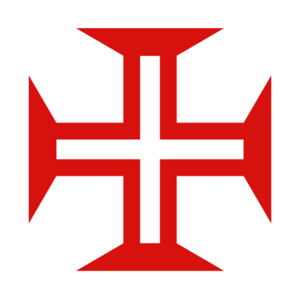
From Dabul, the Portuguese stopped at Chaul. Dom Francisco ordered the town's governor to prepare a tribute for their return from Diu. Moving towards Mahim, near Bombay, the Portuguese found the town empty.
In Bombay, Dom Francisco received a letter from Malik Ayyaz. Ayyaz knew his city was in danger. He wrote to calm the viceroy. He said he had the Portuguese prisoners and that the viceroy's son had fought bravely. He also included a letter from the Portuguese prisoners saying they were well treated. The viceroy replied to Malik Ayyaz (called Meliqueaz by the Portuguese) with a respectful but threatening letter. He stated his intention for revenge. He said they should gather all their forces and prepare to fight. Otherwise, he would destroy Diu:
I the Viceroy say to you, honored Meliqueaz captain of Diu, that I go with my knights to this city of yours, to take the people who were welcomed there, who in Chaul fought my people and killed a man who was called my son, and I come with hope in God of Heaven to take revenge on them and on those who assist them, and if I don't find them I will take your city, to pay for everything, and you, for the help you have done at Chaul. This I tell you, so that you are well aware that I go, as I am now on this island of Bombay, as he will tell you the one who carries this letter.
Problems for the Muslim Side
In the ten months between the Battle of Chaul and Diu, things got worse for the Muslim forces. Hussain used the time to repair his ships. He also got a lost ship back with 300 more men. However, the relationship between Hussain and Ayyaz worsened. Hussain now clearly saw Ayyaz's double-dealing. Ayyaz had taken custody of the Portuguese prisoners from Chaul. Hussain had wanted to send them back to Cairo. Hussain could not pay his remaining troops. He had to pawn his own cannons to Ayyaz. He likely stayed only hoping for more help or fearing the Sultan's reaction.
At this point, Malik Ayyaz faced a tough choice. If he helped Amir Hussain, he risked his city and his life. If he turned on Hussain, the Sultan might punish him severely. If Hussain stayed, he risked being completely destroyed. If he retreated, he risked being executed by the Sultan of Egypt.
Facing these difficult choices, they prepared to meet the Portuguese forces.
Ships in the Battle
Combined Muslim Fleet
- 6 large Mediterranean ships (carracks)
- 6 heavy galleys (Amir Hussain was in charge of these)
- 4 carracks from Diu (Malik Ayyaz's ships)
- 30 light galleys from Diu (Sidi Ali's ships)
- 70–150 war-boats from Calicut (Kunjali Marakkar's ships)
Portuguese Fleet
- 5 large ships called naus:
- Flor de la mar (the Viceroy's main ship; captain João da Nova)
- Espírito Santo (captain Nuno Vaz Pereira)
- Belém (Jorge de Melo Pereira)
- Rei Grande (Francisco de Távora)
- Taforea Grande (Pêro Barreto de Magalhães)
- 4 smaller naus:
- Taforea Pequena (Garcia de Sousa)
- Santo António (Martim Coelho)
- Rei Pequeno (Manuel Teles Barreto)
- Andorinha (Dom António de Noronha)
- 4 square-rigged caravels:
- Flor da Rosa (António do Campo)
- Espera (Filipe Rodrigues)
- Conceição (Pero Cão)
- Santa Maria da Ajuda (Rui Soares)
- 2 caravels:
- Santiago (Luís Preto)
- (Unnamed) (Álvaro Pessanha)
- 2 galleys:
- São Miguel (Diogo Pires)
- São Cristóvão (Paio Rodrigues de Sousa)
- 1 brigantine:
- Santo António (Simão Martins)
The Battle of Diu Begins
On February 2, 1509, the Portuguese saw Diu from their ship's lookout points. As they got closer, Malik Ayyaz left the city. He gave overall command to Hussain. Hussain ordered his oar ships to go out and bother the Portuguese fleet. But they did not go beyond the range of the fort's cannons. As night fell, the Muslim fleet went back into the channel. The viceroy called all his captains to decide what to do.
At dawn, the Portuguese saw that the Muslims had decided to use Diu's protected harbor. They tied their large ships and galleys together close to shore. They waited for the Portuguese to attack, giving up the first move. The Portuguese forces were split into four groups. One group would board the Mamluk large ships after a first attack with cannons. Another group would attack the still Mamluk galleys from the side. A 'bombardment group' would support the rest of the fleet. The main ship, the Flor do Mar, would not join the boarding. Instead, it would position itself to direct the battle and provide firepower. The small ship Santo António would carry messages.
The Santo António then went through the fleet. It delivered the viceroy's speech. He explained why they were fighting the enemy. He also promised rewards for victory. Soldiers would become knights. Knights would gain nobility. Criminals would be pardoned. Slaves would become squires if freed within a year.
Fighting Starts
The wind changed. Around 11:00 am, the royal flag was raised on the Flor do Mar. A single shot was fired, signaling the start of the battle. With a loud cry of Santiago!, the Portuguese began their approach. The galley São Miguel led the way, checking the channel. Both sides fired cannons at each other before the ships clashed. In the calm waters of Diu harbor, the Portuguese used a new cannon tactic. They fired directly at the water. The cannonballs bounced like skipping stones. A full side attack from the Santo Espírito hit an enemy ship below the waterline, sinking it instantly.
As the large ships met, Hussain's main ship was grabbed by the Santo Espírito. When their front parts crossed, a group of men led by Rui Pereira jumped onto the enemy ship. Before the ships were fully secured, the Portuguese had already stormed the middle of the ship. But before Hussain's ship was captured, another Mamluk ship came to help. It boarded the Santo Espírito from the other side. Hussain had added many Gujarati soldiers to his ships. The heavily armored Portuguese soldiers suddenly risked being overwhelmed. Rui Pereira was killed. But at this key moment, the Rei Grande crashed into the free side of Hussain's ship. It brought much-needed reinforcements. This turned the battle in favor of the Portuguese.
Up in the crow's nests, Ethiopian and Turkish archers fought well against Portuguese gunners. Many other Muslim fighters "fled at the first sight of the Portuguese."
Hussain had expected the Portuguese to use all their forces in the main clash. So, he kept his light oar ships back in the channel. He planned to attack the Portuguese from behind once they were busy with the large ships. João da Nova understood this plan. He moved the Flor do Mar to block the channel entrance. This stopped the oar ships from coming out. The crowded oar ships were an easy target for Portuguese gunners. They damaged many ships, which then blocked the path of others. Unable to break through, the Zamorin's boats turned around after a short fight. They retreated to Calicut. During the battle, the Flor do Mar fired over 600 shots.
Meanwhile, the faster galleys and caravels attacked the side of the still enemy galleys. The enemy guns could not fire back. An initial Portuguese attack was pushed back. But a Portuguese volley of shots set three of the galleys adrift.
Slowly, the Portuguese took control of most of the large ships. The smoke made it hard to see. Hussain's main ship was overcome, and many crewmen started jumping off. The galleys were defeated. The shallow caravels positioned themselves between the ships and the coast. They cut down anyone trying to swim ashore.
Finally, only one ship was left. It was a very large ship, bigger than any other in the battle. It was anchored too close to shore for most deep Portuguese ships to reach. Its strong hull could not be damaged by Portuguese cannon fire. It took continuous firing from the whole fleet to finally sink it by dusk. This marked the end of the Battle of Diu.
After the Battle
The battle ended in a clear victory for the Portuguese. The Gujarat-Mamluk-Calicut alliance was almost completely defeated. The Mamluks fought bravely. But they did not know how to fight a naval force like the Portuguese. The Portuguese had modern ships and experienced sailors. Their soldiers were better equipped with heavy armor, early guns (arquebuses), and gunpowder grenades. They had more cannons and better gunners.
After the battle, Malik Ayyaz returned the prisoners from the Battle of Chaul. They were well dressed and fed. Dom Francisco refused to take over Diu. He said it would be too expensive to keep. But he signed a trade agreement with Ayyaz. He also opened a trading post in the city. The Portuguese later wanted to build a fortress at Diu. But Malik Ayyaz managed to delay this as long as he was governor.
The Portuguese took many things from the battle. These included three galleys, three large ships, and 600 bronze cannons. They also took three royal flags of the Mamluk Sultan of Cairo. These flags were sent to Portugal. They were displayed in the Convento de Cristo in Tomar. This was the headquarters of the Order of Christ, which Almeida was part of. The Viceroy made the merchants of Diu pay a large sum of money. They had funded the Muslim fleet. Part of this money was given to the troops, and some to a hospital.
The Portuguese treated the Mamluk captives very harshly. After the battle, Almeida reported to King Manuel: "As long as you may be powerful at sea, you will hold India as yours; and if you do not possess this power, little will avail you a fortress on the shore." After handing over his viceroy post to Afonso de Albuquerque, Almeida left for Portugal in November 1509. In December, he was killed in a small fight against the Khoikhoi tribe near the Cape of Good Hope. Seventy other Portuguese also died, more than in the Battle of Diu. His body was buried on the beach.
Hussain survived the battle. He managed to escape Diu with 22 other Mamluks on horseback. He returned to Cairo. Several years later, he was put in charge of another fleet to fight the Portuguese. But he was murdered in the Red Sea by his Turkish second-in-command. The Mamluk Sultanate of Egypt soon fell to an Ottoman invasion.
Of all the main people in the Battle of Diu, Malik Ayyaz was the only one who did not die a violent death. He died a rich man in his home in 1522.
Battle's Importance
The Battle of Diu is seen as one of the most important battles in history. It marked the start of Western European power in the Indian Ocean. Author William Weir, in his book 50 Battles That Changed the World, ranks this battle as the 6th most important. He says: "When the 15th century began, Islam seemed about ready to dominate the world. That prospect sank in the Indian Ocean off Diu." Historian Rainer Daehnhardt compares this battle to the Battle of Lepanto and Battle of Trafalgar in its importance. According to scholar Michael Adas, this battle "established European Naval superiority in the Indian Ocean for centuries to come."
See also
- Afonso de Albuquerque
- Portuguese conquest of Goa
- Capture of Malacca (1511)
- Portuguese India
- History of Kerala
- Siege of Diu (1538)


